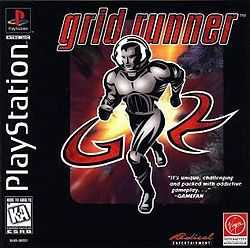Grid Runner
| Grid Runner | |
|---|---|
 Cover art of Grid Runner | |
| Developer(s) | Radical Entertainment |
| Publisher(s) | Virgin Interactive |
| Platform(s) | Saturn PlayStation Windows |
| Release date(s) | PlayStation Windows
|
| Genre(s) | Action game |
| Mode(s) | Single-player, multiplayer |
Grid Runner (known as Grid Run in Europe) is an action game developed by Radical Entertainment and published by Virgin Interactive for the Sega Saturn, PlayStation and Microsoft Windows in 1996.
Plot
The protagonist Axxel and his partner Tara, a pair of freelance space adventurers, are sent on a mission to the Gridonion Asteroid Field, a path between Earth and the Nether-Planets, to find out why ships have been mysteriously disappearing. While investigating a seemingly deserted ship in the asteroid field, Axxel is captured by the evil Empress Vorga, who then forces Axxel to play a deadly game against her 14 minions. If the player manages to beat the game, Axxel destroys Vorga in the final battle and escapes the ship just before it blows up.
Gameplay
Grid Runner is a top-down game similar to tag. The object of the game is to change a set amount of flags scattered around the playfield to the colour of your player. Upon starting the game, two players must race to find the first flag. The first player to get to this flag will change the flag's color to blue or red (player 1 or player 2's color, respectively). The loser will then be marked as "it" and must then hunt down the other player "tagging" them and making them "it" instead. Only the player not marked as "it" may change the colours of the flags, and as soon as the desired number of flags have been changed, that player will win.
The map takes a grid-like form, featuring numerous types of tiles allowing the player to speed up in one direction, teleport or allow further pathways to appear. Each player is armed with a laser gun that can slow the opponent down, and each player may build "bridges" to overcome gaps. You may also use magic found on the map to slow down your opponent, teleport or speed up. Shields and time for the bonus stages are also collectible.
Each level is split into three rounds against an opponent, which the player must win in order to succeed. Opponents often come with certain abilities, giving them better control on ice for example, or being able to build two "bridges" at once. After each level there is a bonus level in which more magic can be obtained.
Reception
| Reception | ||||||||||||||||||||||||||||||||||||||||||||||||||||||||||||||||||
|---|---|---|---|---|---|---|---|---|---|---|---|---|---|---|---|---|---|---|---|---|---|---|---|---|---|---|---|---|---|---|---|---|---|---|---|---|---|---|---|---|---|---|---|---|---|---|---|---|---|---|---|---|---|---|---|---|---|---|---|---|---|---|---|---|---|---|
| ||||||||||||||||||||||||||||||||||||||||||||||||||||||||||||||||||
References
- ↑ Playground Mayhem or Futuristic Fun?, www.GameInformer.com, October 1996 archived
- ↑ Jason Parks, Grid Runner Review, GameSpot, November 7, 1996
- ↑ Grid Runner, IGN, Fubrueary 11, 1997
- ↑ PC Gamer Online | Grid Runner